Hands on with Laster SeeThru, a direct augmented-reality challenge to Google Glass
Turn back your technology clock to April 5, 2012, the day Google introduced wearable tech to mainstream consumers, and permanently changed the trajectory of mobile hardware. Google, if you’ll remember, released a provocative video for what was then called Project Glass. The video showed what it’s like to wear smartglasses with full augmented reality overlays from morning until dusk.
It looked positively delightful. As well it should have. It turns out it was just a concept video.
Google’s vision told us that all our science-fiction dreams were coming true, but as the company released more information about its smartglasses’ true capabilities, we learned that Glass offers none of the full-screen information overlays portrayed in the original video. It was a blow for augmented-reality enthusiasts, but now a small French company called Laster Technologies is gearing up to launch SeeThru, a head-mounted wearable that attempts to make good on the original Google promise.
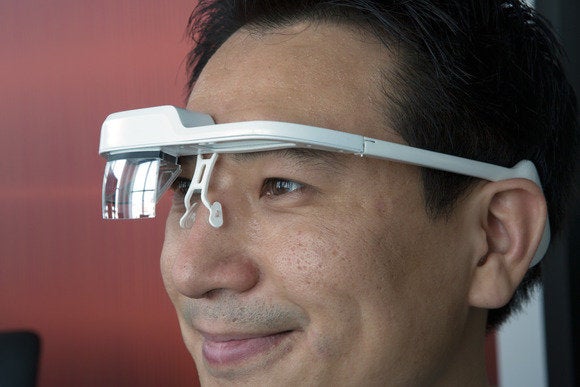 Image: Dan Masaoka
Image: Dan Masaoka Laster CEO Zile Liu models the SeeThru.
“With augmented reality, the Internet comes to the real world,” Laster CEO Zile Liu told TechHive. “We take the glasses, we see an object, and the object gives us information about what it is. This is the future. We have more efficient information, directly in our field of view.”
Sure, but does it work? I tested a rough prototype of the SeeThru smartglasses, which are currently being crowd-funded in a Kickstarter campaign that intends to ship models in June for $400 a pop. Without a doubt, the SeeThru glasses do things that Google’s glasses cannot. But whether humankind is ready for Laster’s vision is a different matter entirely.
How much augmented reality is too much?
The SeeThru offer a 800x600 display with a 25 degree diagonal field of view—that’s about twice the display window of Google Glass. The idea is to wear the specs only for specific activities that can directly benefit from contextual information overlays. So, for example, you could wear them while sightseeing in a foreign city to see factoids about historical landmarks: Simply glance at la Colonne de Juillet, and you’ll see an overlay telling you when the column was built, and how far away it is from your current location.
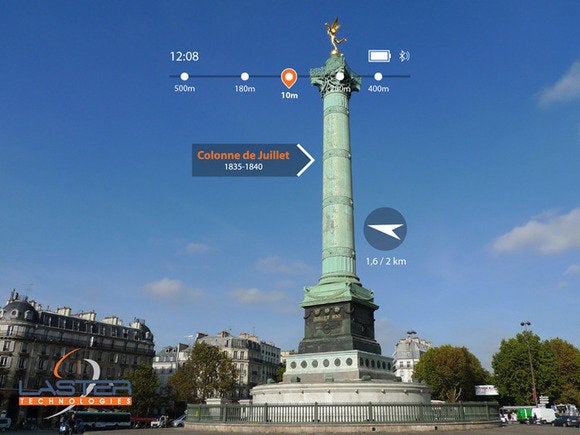 Image: Laster Technologies
Image: Laster Technologies Laster’s mock-up of a sight-seeing app looks inviting, but our demo with a rough prototype didn’t reveal such engaging visuals.
Laster also plans to make the SeeThru sturdy enough for more extreme pastimes, providing users with head-up display data while they skateboard, hang glide, sail the seas, and fly airplanes. Liu wasn’t able to show me any of these applications in action, but says they’ll be ready by the end of the year. During my demo, I only played with two apps—a rudimentary game and a barebones GPS interface—but even my limited time with SeeThru was enough to provoke a nagging question: Do we really want this much augmented reality content directly in our lines of sight?
Consider: The Google Glass display sits on the far upper-right periphery of the user’s vision. For me, that display location creates eyestrain, especially when I focus on Google’s screen for extended periods, or have to switch back and forth between normal vision and Google vision a number of times in quick succession. But with the SeeThru glasses, digital content appears squarely in the middle of your field-of-vision.
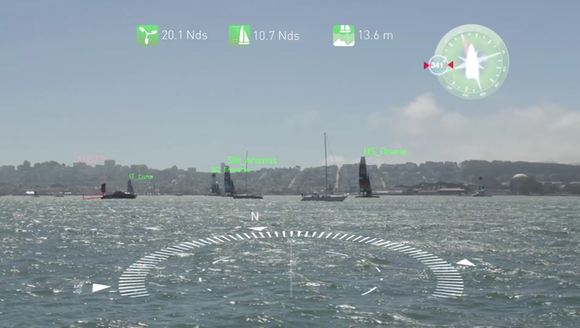 Image: Laster Technologies
Image: Laster Technologies The sailing app is due by the end of 2014. Will it look this stunning when it’s released?
This approach didn’t tax my eye muscles the way Google Glass does, but I did find the experience disorienting. I’m just not sure that I want to walk the streets of Paris—or, yikes, fly a hang glider—with a bunch of digital content dominating so much of what I see. And even if the augmented reality overlays don’t pose a distraction hazard, I have to imagine they’ll still require a lengthy orientation process before they begin to feel natural.
Liu concedes that augmented reality can’t be a 24-7 experience. “People aren’t ready to wear augmented reality glasses every hour of every day. It takes time to get used to these kinds of glasses,” he says. “But in some situations, like sports, when you’re biking or skateboarding, you can wear these for a new experience.”
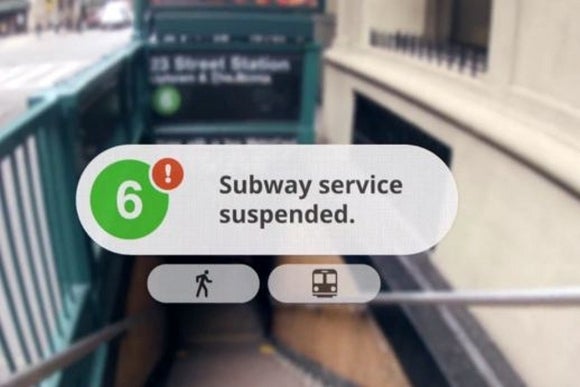 Image: Google
Image: Google Let’s not forget that Google’s Project Glass video made augmented reality look marvelous—but features like what we see here aren’t available in the current iteration of Google Glass.
You can check out the video at the top of this article to get an idea of what the SeeThru overlays look like in person. What you see in the video what shot directly through the glasses with a GoPro camera. We demoed a rough, wired prototype of the glasses with an OLED display. Liu says the final version will be completely wireless and come with an LCOS display that’s three times brighter.
Brighter overlays will be imperative, especially if the SeeThru glasses are to fulfill the promise of the screenshots on Laster’s Kickstarter page (and shown here). The mock-ups show bright, bold augmented-reality overlays with text that’s large enough to comfortably read, but the GPS app that I tested during my demo was difficult to visually resolve. Let’s hope Laster fixes this in its final apps, because if content is going to occupy dead-center in your line of sight, you won’t want to wrestle with what that teeny-tiny text actually means.
All the sensors without the expensive processing
Just like Google Glass, the SeeThru are aesthetically challenged. You can’t wear these things without feeling like a complete tool, but at least if you’re wearing them for very specific and extreme applications, the world’s fashion critics might give you a pass. (Sightseers in foreign lands would be advised to travel with other smartglass owners, because, you know, there’s safety in numbers and you don’t want this to happen.)
 Image: Dan Masaoka
Image: Dan Masaoka No, these aren’t the smartglasses you’ll wear to your next job interview or blind date.
The prototype I demoed wasn’t particularly heavy, and Liu says the final version will be even lighter at around 2 ounces. Unlike Glass, the SeeThru specs don’t include a camera. This helps reduce costs, and eliminates challenges from privacy advocates. Nor do the SeeThru include a CPU, memory or onboard storage. The idea is to connect to your smartphone over Bluetooth, and rely on the handset for all the heavy lifting. As Liu says, “Why are we asking people to pay twice for CPUs and memory?”
Accurately tracking head movement is key to SeeThru’s system, so the apparatus is packed with sensors that help make sure all those contextual overlays map perfectly over what you actually see. Three accelerometers, three gyroscopes and three compasses are embedded in the frames, and the built-in battery is rated to last between 6 and 8 hours of use. You can navigate the UI with voice control (Laster uses Google’s voice-recognition engine), and there are also a pair of buttons for simple menu navigation.
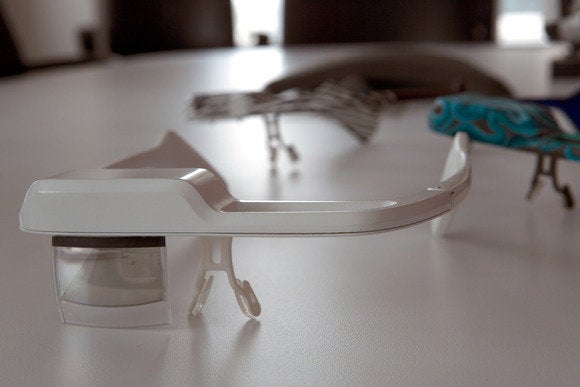 Image: Dan Masaoka
Image: Dan Masaoka SeeThru’s display is a main selling point. With a 25-degree diaginal field of view, it places content large and in charge in the middle of your sight line.
Assuming Laster reaches its Kickstarter goal, the SeeThru will ship to backers in June with two apps: AR GPS will provide basic mapping and directions, while AR Navigation will add landmark overlays for sightseers. Liu says the apps will pull their data from Google Maps and Wikitude, an existing augmented reality data platform.
Will Liu and Laster beat Google to market? We’ll see—but Google maintains that the consumer release of Glass is still on track for a “wider consumer launch later in 2014.” But perhaps Google really isn’t Laster’s main competitor. An Italian company called GlassUp is also going the pure augmented-reality route, and Epson is prepping the second generation of its augmented-reality Moverio glasses. And of course there’s Meta, which is throwing the whole kitchen sink at augmented-reality glasses.
As the year takes shape, prepare yourself for a face-off between opposing smartglass philosophies, with augmented-reality advocates on one side, and Google on the other. Google Glass doesn’t have those oh-so-intriguing contextual overlays—yet—but it does enjoy the power of Google Now, all of Google’s mature platform services, and the collective alpha-testing intelligence of legions of Glass Explorers.
The battle lines are drawn. And of course there’s always a third possibility: It might turn out that neither smartglasses approach is consumer-friendly, and all would-be competitors will stand down in defeat.
